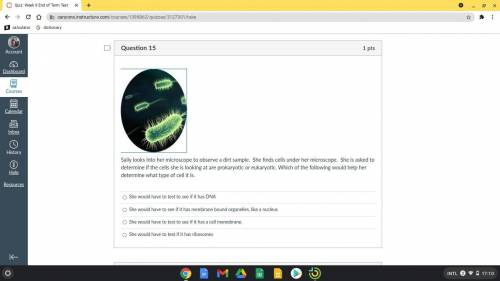
Biology, 19.03.2021 02:20 jaydenrobinettewca
Sally looks into her microscope to observe a dirt sample. She finds cells under her microscope. She is asked to determine if the cells she is looking at are prokaryotic or eukaryotic. Which of the following would help her determine what type of cell it is.
She would have to test to see if it has DNA
She would have to see if it has membrane bound organelles, like a nucleus
She would have to test to see if it has a cell memebrane.
She would have to test if it has ribosomes


Answers: 1


Another question on Biology

Biology, 22.06.2019 02:30
Plz ! for many generations farmers in north america have been choosing to cross corn plants with large ears of corn each year this results in the new generation of plants also growing large ears of corn. what is the technique called? a. selective breeding. b. natural selection. c. mitosis. d. asexual budding.
Answers: 1

Biology, 22.06.2019 03:30
For this question look at the hydropic diagram water that is heated by the sun evaporates. select the number that represents it.
Answers: 1

Biology, 22.06.2019 05:10
7. describe two strategies that parents can use to cope with stress. 8. describe the three types of childcare available to families. 9. what can parents do to be more involved in their children's education at home and at school? 10. which factors should a parent consider when choosing a childcare option?
Answers: 1

Biology, 22.06.2019 05:20
Use this dichotomous key for insect identification to identify the insect shown. 1. a. insect has one pair of wings. order diptera b. insect has two pairs of wings. go to #2 2. a. front wings thicker in texture than hind wings go to #3. b. front and hind wings are same texture throughout. go to #4 3. a. front wings are short order dermaptera b. front wings cover entire abdomen order coleoptera 4. a. wings with scale on all parts of their area. order lepidoptera b. wings without scales go to #5. 5. a. hind wings smaller than front wings. order ephemeroptera b. front and hind wings nearly equal in size. order odonata the insect pictured is in the order diptera. ephemeroptera. coleoptera. odonata.
Answers: 3
You know the right answer?
Sally looks into her microscope to observe a dirt sample. She finds cells under her microscope. She...
Questions

Mathematics, 10.11.2021 19:30

Mathematics, 10.11.2021 19:30

Mathematics, 10.11.2021 19:30

English, 10.11.2021 19:30

Mathematics, 10.11.2021 19:30

Arts, 10.11.2021 19:30

English, 10.11.2021 19:30

History, 10.11.2021 19:40


History, 10.11.2021 19:40

Mathematics, 10.11.2021 19:40




Physics, 10.11.2021 19:40

Physics, 10.11.2021 19:40

Chemistry, 10.11.2021 19:40

Biology, 10.11.2021 19:40


History, 10.11.2021 19:40



